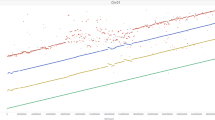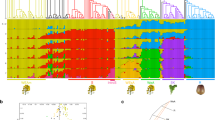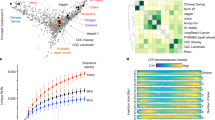Abstract
Polyploidy complicates genomics-based breeding of many crops, including wheat, potato, cotton, oat and sugarcane. To address this challenge, we sequenced leaf transcriptomes across a mapping population of the polyploid crop oilseed rape (Brassica napus) and representative ancestors of the parents of the population. Analysis of sequence variation1 and transcript abundance enabled us to construct twin single nucleotide polymorphism linkage maps of B. napus, comprising 23,037 markers. We used these to align the B. napus genome with that of a related species, Arabidopsis thaliana, and to genome sequence assemblies of its progenitor species, Brassica rapa and Brassica oleracea. We also developed methods to detect genome rearrangements and track inheritance of genomic segments, including the outcome of an interspecific cross. By revealing the genetic consequences of breeding, cost-effective, high-resolution dissection of crop genomes by transcriptome sequencing will increase the efficiency of predictive breeding even in the absence of a complete genome sequence.
This is a preview of subscription content, access via your institution
Access options
Subscribe to this journal
Receive 12 print issues and online access
$209.00 per year
only $17.42 per issue
Buy this article
- Purchase on Springer Link
- Instant access to full article PDF
Prices may be subject to local taxes which are calculated during checkout



Similar content being viewed by others
Accession codes
References
Trick, M., Long, Y., Meng, J. & Bancroft, I. Single nucleotide polymorphism (SNP) discovery in the polyploid Brassica napus using Solexa transcriptome sequencing. Plant Biotechnol. J. 7, 334–346 (2009).
Rounsley, S. et al. De novo next generation sequencing of plant genomes. Rice 2, 35–43 (2009).
Huang, S. et al. The genome of the cucumber, Cucumis sativus L. Nat. Genet. 41, 1275–1281 (2009).
Velasco, R. et al. The genome of the domesticated apple (Malus x domestica Borkh.). Nat. Genet. 42, 833–839 (2010).
Shulaev, V. et al. The genome of woodland strawberry (Fragaria vesca). Nat. Genet. 43, 109–116 (2011).
Argout, X. et al. The genome of Theobroma cacao. Nat. Genet. 43, 101–108 (2011).
The Brassica rapa Genome Sequencing Consortium. The genome of the mesohexaploid crop species Brassica rapa. Nat. Genet. (in the press).
Arabidopsis Genome Initiative. Analysis of the genome of the flowering plant Arabidopsis thaliana. Nature 408, 796–815 (2000).
International Rice Genome Sequencing Initiative. The map-based sequence of the rice genome. Nature 436, 793–800 (2005).
U, N. Genome analysis in Brassica with special reference to the experimental formation of B. napus and peculiar mode of fertilization. Jap. J. Bot. 7, 389–452 (1935).
Lagercrantz, U. & Lydiate, D. Comparative genome mapping in Brassica. Genetics 144, 1903–1910 (1996).
O'Neill, C.M. & Bancroft, I. Comparative physical mapping of segments of the genome of Brassica oleracea var. alboglabra that are homoeologous to sequenced regions of chromosomes 4 and 5 of Arabidopsis thaliana. Plant J. 23, 233–243 (2000).
Rana, D. et al. Conservation of the microstructure of genome segments in Brassica napus and its diploid relatives. Plant J. 40, 725–733 (2004).
Schranz, M.E., Lysak, M.A., Mitchell-Olds, T. & The, A.B. C's of comparative genomics in the Brassicaceae: building blocks of crucifer genomes. Trends Plant Sci. 11, 535–542 (2006).
Arumuganathan, K. & Earle, E.D. Nuclear DNA content of some important plant species. Plant Mol. Biol. Rep. 9, 208–218 (1991).
Trick, M. et al. A newly-developed community microarray resource for transcriptome profiling in Brassica species enables the confirmation of Brassica-specific expressed sequences. BMC Plant Biol. 9, 50 (2009).
Qiu, D. et al. A comparative linkage map of oilseed rape and its use for QTL analysis of seed oil and erucic acid content. Theor. Appl. Genet. 114, 67–80 (2006).
Suwabe, K., Morgan, C. & Bancroft, I. Integration of Brassica A genome genetic linkage map between Brassica napus and B. rapa. Genome 51, 169–176 (2008).
Parkin, I.A. et al. Segmental structure of the Brassica napus genome based on comparative analysis with Arabidopsis thaliana. Genetics 171, 765–781 (2005).
Town, C.D. et al. Comparative genomics of Brassica oleracea and Arabidopsis thaliana reveal gene loss, fragmentation, and dispersal after polyploidy. Plant Cell 18, 1348–1359 (2006).
Yang, T.J. et al. Sequence-level analysis of the diploidization process in the triplicated FLOWERING LOCUS C region of Brassica rapa. Plant Cell 18, 1339–1347 (2006).
Cheung, F. et al. Comparative analysis between homoeologous genome segments of Brassica napus and its progenitor species reveals extensive sequence-level divergence. Plant Cell 21, 1912–1928 (2009).
Sharpe, A.G. & Lydiate, D.J. Mapping the mosaic of ancestral genotypes in a cultivar of oilseed rape (Brassica napus) selected via pedigree breeding. Genome 46, 461–468 (2003).
Shi, J. et al. Unraveling the complex trait of crop yield with quantitative trait loci mapping in Brassica napus. Genetics 182, 851–861 (2009).
You, F.M. et al. Annotation-based genome-wide SNP discovery in the large and complex Aegilops tauschii genome using next-generation sequencing without a reference genome sequence. BMC Genomics 12, 59 (2011).
Li, H., Ruan, J. & Durbin, R. Mapping short DNA reads and calling variants using mapping quality scores. Genome Res. 18, 1851–1858 (2008).
Van Ooijen, J.W. & Voorrips, R.E. JoinMap 3.0, Software for the Calculation of Genetic Linkage Maps (Plant Research International, Wageningen, the Netherlands, 2001).
Acknowledgements
We thank The Genome Analysis Centre for generating Illumina sequence data and the Warwick HRI Genetic Resources Unit for seeds of cultivar Regent. This work was supported by UK Biotechnology and Biological Sciences Research Council (BBSRC BB/E017363/1, ERAPG08.008), UK Department for Environment, Food and Rural Affairs (Defra IF0144) and by China National Basic Research and Development Program (2006CB101600 and 2011CB109300).
Author information
Authors and Affiliations
Contributions
I.B. and M.T. conceived and planned the project. F.F., L.C. and D.B. carried out the experiments. I.B., C.M., J.H., R.W. and M.T. performed data analysis. Y.L. and J.M. provided materials and scoring data for conventional markers on the population. X.W. and S.L. provided access to unpublished genome sequence scaffolds. I.B. and M.T. wrote the manuscript and all authors reviewed it.
Corresponding author
Ethics declarations
Competing interests
The authors declare no competing financial interests.
Supplementary information
Supplementary Text and Figures
Supplementary Tables 1, 2 and Supplementary Figures 1–6 (PDF 1058 kb)
Supplementary Data Set 1
Marker details for the cognate linkage map (XLS 17059 kb)
Supplementary Data Set 2
Marker details for the non-cognate linkage map (XLS 1280 kb)
Supplementary Data Set 3
Base counts at IHP positions in Tapidor and Ningyou 7 (XLS 9928 kb)
Supplementary Data Set 4
Coordinates for splitting of Brassica rapa and Brassica oleracea genome assembly scaffolds (XLS 14 kb)
Supplementary Data Set 5
B. rapa and B. oleracea genome scaffolds anchored to the B. napus (XLS 781 kb)
Supplementary Data Set 6
Marker alleles scored in ancestors of Tapidor and Ningyou 7 (XLS 4352 kb)
Supplementary Data Set 7
Perl script combiner.pl (TXT 20 kb)
Supplementary Data Set 8
Perl script cure_cycle.pl (TXT 2 kb)
Supplementary Data Set 9
Perl script cure_refseqs.pl (TXT 3 kb)
Supplementary Data Set 10
Perl script ihp.pl (TXT 11 kb)
Supplementary Data Set 11
Perl script tag_counter.pl (TXT 2 kb)
Supplementary Data Set 12
Perl script AC_count.pl (TXT 7 kb)
Rights and permissions
About this article
Cite this article
Bancroft, I., Morgan, C., Fraser, F. et al. Dissecting the genome of the polyploid crop oilseed rape by transcriptome sequencing. Nat Biotechnol 29, 762–766 (2011). https://doi.org/10.1038/nbt.1926
Received:
Accepted:
Published:
Issue Date:
DOI: https://doi.org/10.1038/nbt.1926
This article is cited by
-
DNA fingerprinting and genetic diversity analysis in Asparagus officinalis L. cultivars using microsatellite molecular markers
Genetic Resources and Crop Evolution (2023)
-
The landscape of genome sequencing and assembling in plants
Functional & Integrative Genomics (2022)
-
Validation of a novel associative transcriptomics pipeline in Brassica oleracea: identifying candidates for vernalisation response
BMC Genomics (2021)
-
In-depth evaluation of root infection systems using the vascular fungus Verticillium longisporum as soil-borne model pathogen
Plant Methods (2021)
-
Identification of genes associated with the biosynthesis of unsaturated fatty acid and oil accumulation in herbaceous peony ‘Hangshao’ (Paeonia lactiflora ‘Hangshao’) seeds based on transcriptome analysis
BMC Genomics (2021)



